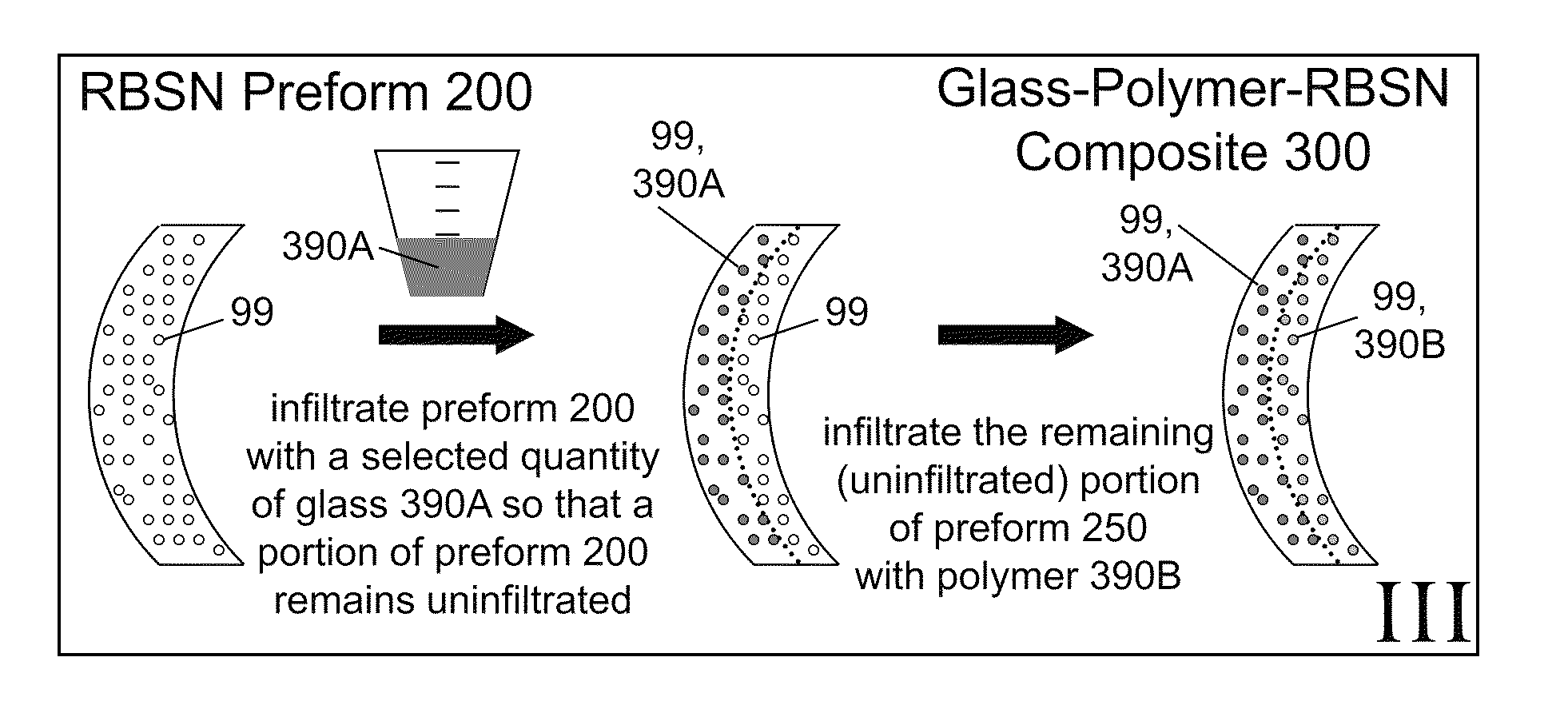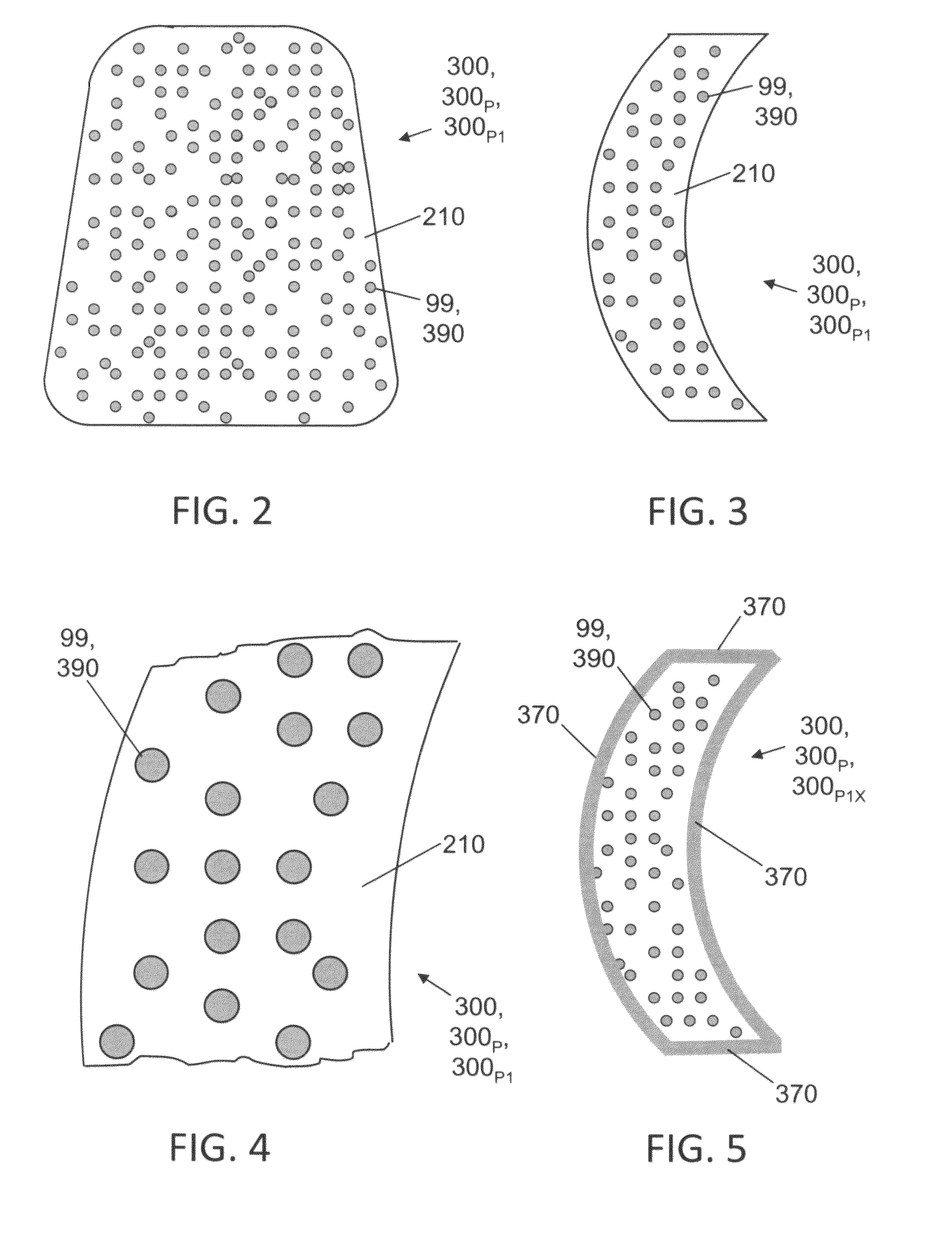Lightweight ballistic armor including non-ceramic-infiltrated reaction-bonded-ceramic composite material
a composite material, non-ceramic technology, applied in the direction of ceramicware, prosthesis, other domestic articles, etc., can solve the problems of inability to stop greater projectile threats, inability to withstand projectile impact, and failure of conventional ceramic armor materials, etc., to achieve superior performance in terms of projectile impact resistan
- Summary
- Abstract
- Description
- Claims
- Application Information
AI Technical Summary
Benefits of technology
Problems solved by technology
Method used
Image
Examples
example 1
Glass-Infiltrated RBSN Composite Body Armor Plates
[0066]The inventive composite armor devices 300 depicted in FIG. 2 through FIG. 5 are inventive composite armor devices 300 of the homogeneously infiltrated kind. Inventive body armor plate 300P1 (shown in FIG. 2 through FIG. 4) and inventive body armor plate 300P1X (shown in FIG. 5) each include an RBSN preform phase 210 and a glass infiltrant phase 390. Glass infiltrant phase 390 at least substantially occupies the interstices (pores) defined by RBSN preform phase 210. The difference between inventive body armor plate 300P1 and inventive body armor plate 300P1X is glass infiltrant material coating 370, present in the latter.
[0067]The first (green body production) stage of fabrication of inventive body armor plate 300P1 or 300P1X results in a porous silicon green body 100 having the same or approximately the same geometric shape as that shown in FIG. 2 and FIG. 3 of inventive body armor plate 300P1. The second (preform production) s...
example 2
Glass-Polymer-Infiltrated RBSN Composite Body Armor Plates
[0072]FIG. 6 through FIG. 11 can be understood to be illustrative of an inventive double-layer configuration characterized by any one of the following combinations of dissimilar composite materials: glass-infiltrated RB ceramic and polymer-infiltrated RB ceramic; glass-infiltrated RB ceramic and metal-infiltrated RB ceramic; metal-infiltrated RB ceramic and polymer-infiltrated RB ceramic.
[0073]Let us assume that the inventive composite body armor device 300 depicted in FIG. 6 through FIG. 11 is an inventive double-layer composite body armor plate 300P2 having: (a) a glass-infiltrated RBSN layer 350A, with the glass phase 390A filling larger preform 200 pores 99; and, (b) a polymer-infiltrated (e.g., elastomer-infiltrated) RBSN layer 350B, with the polymer 390B filling smaller preform 200 pores 99. Although we are proceeding on this assumption by way of example, it is to be recognized that, alternatively, the inventive double-...
example 3
Glass-Metal-Polymer-Infiltrated RBSN Composite Body Armor Plates
[0088]Inventive plural-infiltrant body armor plates 300P2 (shown, by way of example, in FIG. 6 through FIG. 11) are of the inventive double-infiltrant variety. In contrast, exemplary inventive plural-infiltrant body armor plate 300P3, shown in FIG. 12, is of the inventive triple-infiltrant variety. Glass-metal-polymer-Infiltrated RBSN composite body armor plate 300 includes a glass-infiltration region 350A, a metal-infiltration (e.g., aluminum-infiltration, steel-infiltration, or titanium-infiltration) region 350C, and a polymer-infiltration (e.g., elastomer-infiltration) region 350B. The three regions of the generally flat-shaped inventive body armor plate 300P3 are aptly described as “layers.” In the inventive triple-layer body armor plate 300P3, glass-infiltration layer (region) 350A and polymer-infiltration layer (region) 350B “sandwich” therebetween the metal-infiltration layers (region) 350C.
[0089]A decreasingly “...
PUM
| Property | Measurement | Unit |
|---|---|---|
| porosity | aaaaa | aaaaa |
| porosity | aaaaa | aaaaa |
| porosity | aaaaa | aaaaa |
Abstract
Description
Claims
Application Information
 Login to View More
Login to View More - R&D
- Intellectual Property
- Life Sciences
- Materials
- Tech Scout
- Unparalleled Data Quality
- Higher Quality Content
- 60% Fewer Hallucinations
Browse by: Latest US Patents, China's latest patents, Technical Efficacy Thesaurus, Application Domain, Technology Topic, Popular Technical Reports.
© 2025 PatSnap. All rights reserved.Legal|Privacy policy|Modern Slavery Act Transparency Statement|Sitemap|About US| Contact US: help@patsnap.com



